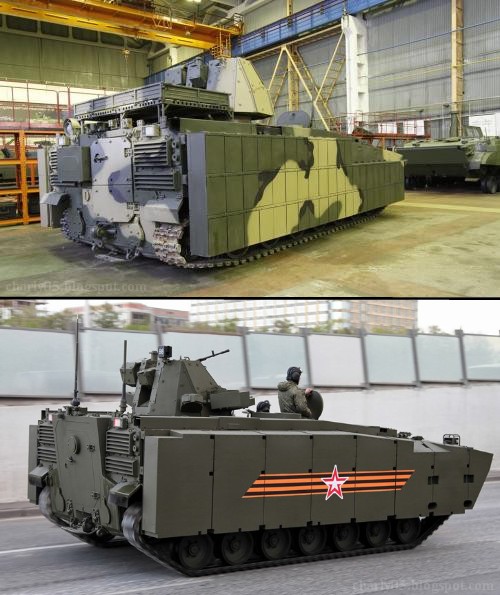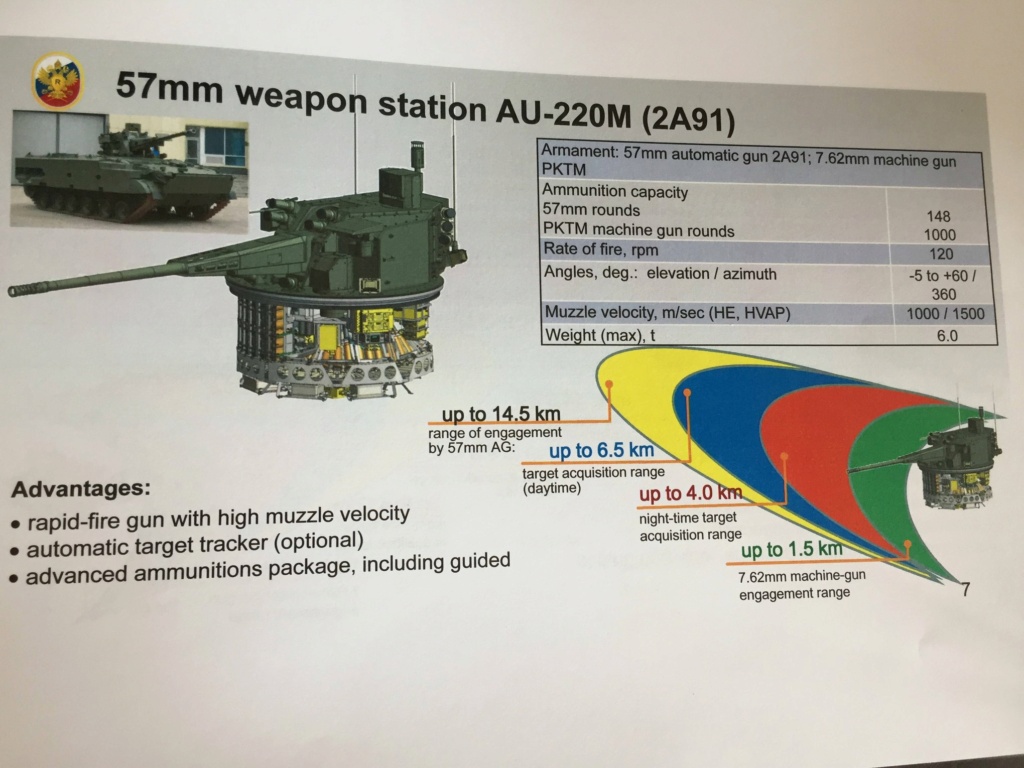> The families are different among them and therefore oriented towards a certain set of missions. One family of wheeled vehicles will not produce heavy tanks for instance, the Armata family will not make sense for light vehicles etc.
I would suggest a missing piece in the family could be filled in using drones.
Light mobile drones could be used for recon in an Armata based force... and to be honest it makes more sense to me having forward deployed eyes and ears and weapons in light drones on the ground and in the air would give a ground based force better awareness of the situation around them than sending forward a few jeeps with guys with binos...
For the light family a light vehicle with lots of missiles and a low recoil gun could be used in the "tank" role... Even if it is a 120mm gun/mortar... or indeed they could do to the 100mm rifled gun of the BMP-3 what they did to the 57mm grenade launcher... with a large APFSDS round and much stronger barrel...
Of course the 120mm gun/mortar could be used to launch a version of the Sokol-V 125mm gun launch guided missile... with perhaps an 8km range instead of the 12km range it is supposed to have...
I don't think any of the vehicles are going to run out of fire power...
> Due to the way platform introduction and retirement from service works in Russian military, the complete substitution of older families by a single one standardized for i.e. a divisional unit is not likely.
It was less than 10 years ago that people were complaining because no two Russian soldiers wore the same uniform... most of the time the pants didn't even match the jacket. There were about 7 or 8 different patterns and colours used for different environments and the seasons... plus white for snow camo... if you had suggested then that their uniforms could become uniform I would have doubted you... and probably said it would be better to get good body armour and helmets into general use... and they have managed both.
The Boomerang based vehicles will be much cheaper than existing types simply because wheeled vehicles are easier and quicker to maintain and operate, especially if you need to go any distance in them... having forces armed only with them will dramatically reduce costs of training and exercises, and in many places improve mobility too.
They would also be the cheapest type to put into mass production so I would expect them to rapidly replace the older equipment.
The problems with the Kurganets will likely mean those forces get older gear for a bit longer, but when I say older gear I mean upgraded previous generation gear which is not the worst stuff they could be using.
As I keep suggesting they are not going to have thousands and thousands of T-14 tanks.
The new technology they will be using they might find they can mix roles for some of the existing 26-27 different types so they can get away with fewer actual types doing the same job.
The same way Ratnik reduces the number of different things that need to be carried by combining features and making things multifunction...
Within the famility you need also a different number of pieces that are unique, not only engines and transmissions.
Of course... within the Armata family the 120mm gun/mortar carrier vehicle will have a unique 120mm gun/mortar, but teh Kurganets mortar carrier and the Boomerang mortar carrier will have the same gun with the same ammo. The Typhoon might keep their weight down by using an 82mm mortar for their family... but then the NONA is not a heavy vehicle and it manages to use it effectively... and the 2S23 based on the 14 ton BTR-80 chassis has a 120mm mortar as well so who knows...
Your list of spares will be longer indeed, but the amount of pieces in total and needed investment will not. And if the platforms have already been in use for a while, your tools are there, as well as your trained technicians, so it does not mean any serious additional expense.
As long as they still get the job done having four different vehicle bases instead of over a dozen makes management and support easier and cheaper... having to keep spare parts for three different BMP vehicles all perhaps present in the same unit that are not interchangeable would be a pain in the arse.
Of course if they have the parts then it makes sense to use them, but situations where they kept the 2S1 in use because although the gun is getting old and they wanted to retire it the new electronics made them viable and potentially useful weapons and they had plenty of spare parts... from memory the chassis is the GTSM chassis that is also a mine vehicle and has other uses as well, so they were replacing its 122mm D-30 gun for the 120mm gun/mortar... it had slightly less range but could use 120mm mortar shells, 120mm shells, 120mm Gran guided missiles, and 122mm Kitilov guided missiles. The range was 13km with the 120mm shells and 15km with the 122mm gun so there was not a huge loss in performance but the rounds were also used in mortars still in use.
They have brought the 2S7 and 2S4 out of retirement because of their ammo offers capabilities existing new types can't match... 70km range 152mm shells is very useful but when the target is much closer but your 40kg shells are not doing enough damage then 203mm 110kg shells or 240mm 130kg shells can be more effective against some targets.
I doubt they would both making Armata versions of these vehicles... because they don't need them in large numbers, though it is possible they might make towed or wheeled models for mobility and low operating costs when the current vehicles are worn out... I am still hoping for a joint Army/Navy 203mm gun programme...
I a m not so sure, US evolved their army into some relatively lighter expeditionary forces, all the while Russia developed the heavy platform Armata and created a huge IFV like the T-15. APS is indeed a new factor to take into account that to a degree decouples protection and armour, but still Russian military is not putting all their eggs in that basket, not yet.
They have never put all their eggs in one basket, the fundamental common theme through all their families of vehicles is separating crew from ammo and fuel, and putting them behind the best armour on the vehicle.
Existing vehicle types don't have that feature... including all the support vehicles, which is just another reason to replace them...
Well, it is (I think) more an issue of level of threat than of heavy vs. light platforms. So they can have heavy platforms like T-72 tanks and other not so modern vehicles... that makes more economic sense than replacing all units in low risk environments with new technology. They do not introduce the new platforms all at once like the US does, they don't retire them all at once either.
I am not suggesting they replace them all at once.... it would be physically impossible to replace them all at once because most of the vehicles that they would need are not developed yet...
Expeditionary forces in non combatant mode (like Syria) is what Bumerang is ideal for. In fighting roles, Syria uses tanks above all, no matter how old, because even without enemy tank formations, they are the best thing that has been invented to assault an enemy position safely and with the capacity to eliminate fortifications. IFVs are not even close, even when 57 mm grenades are going to be revolutionary in this regard, a tank cannon is something else.
When the threat from the enemy does not really include large numbers of tanks I would suggest an APS system adapted that is optimised to intercept HEAT rockets and missiles further from the protected armoured vehicle to reduce its effect on the armour to zero... meaning a Boomerang would be just as well protected as a T-90. With Armata level optics and sensors I would think the turret with the 57mm grenade launcher should actually be the turret of choice for such a situation... 7-8kgs of HE per shot would probably be very comparable with a 125mm HE shell, and the APFSDS round would punch through any armoured truck or vehicle IEDs... and at 120 rounds per minute would be devastating. Air burst HE would be very effective too.
When it comes to taking down heavy structures I would think calling in 152mm artillery or TOS, or even air attack would make more sense using appropriate tools for the job... we have seen the Syrians have Tulip... the guidance systems for the standard 152mm rounds for Coalition are electronic nose mounted fuses that have control vanes to steer the round... the 203mm and 240mm weapons use the same standard heavy fuses as the 152mm and 160mm mortar weapons do, so it should already be compatible with the ammo...
The fact that Spruts is not like the T-90 turret in any regard is a hint to me that we will not see the Armata RCWS on the Bumerang or Kurganets.
That is not really very logical... the Spruts turret is for an 18 ton tracked amphibious vehicle... there was never a possibility of fitting the T-90s turret on to it simply because the turret would probably weigh half as much again as the vehicle chassis it was being put on.
There is no point in having 500mm+ of turret cheek armour protecting the head and upper body of the gunner and commander if the hull armour offered less than 100mm of protection for their lower bodies and all the ammo the vehicle was carrying.
The Epoch turret in the 30mm cannon model and the 57mm grenade launcher model and the 57mm high velocity gun model seem to be the same for the Armata and Kurganets and Boomerang... the tiny APC turret with the single Kord HMG mount seem the same across the types too... why do you think the MBT turret would need to change?
Do lighter vehicles not need optics and APS radar sensors and all the other things already fitted to the turret?
What possible changes would you make? Make it smaller? Meaning less room for equipment so the tanks in lighter brigades have less capable tanks...
Making them all the same would actually increase production numbers and allow a more uniform performance and probably help keep costs down.
Certainly if you run out of spares for your MBTs or BMPs being able to go to any other unit and borrow some items makes sense if they all use the same stuff where possible.
I mean what is the point of being the light mobile force if you need to get a slow heavy tank to come forward to capture video of the target because your camera in your Boomerang force is stink... because it was cheaper...
They will still have generations of tanks, Shoigu has just said the T-72 are not going anywhere. Cost / weight and intended roles are not independent IMHO as you say. That is, some roles demand a heavy or a light platform. That is what we see different.
They have scrapped a lot of tanks recently... to the point where they had to buy some T-34s from a foreign country, but just because they are introducing new vehicles does not mean the current upgraded models are going to be scrapped. They will go into reserve of course and if a job comes up for which an upgraded T-72 makes more sense than sending Armata tanks then of course they will do that.
These new vehicle types are supposed to make them more flexible... not less flexible.
Currently the command vehicle in a unit is the ACRV-2 and it is an MTLBu based vehicle. There will be older models in use in service based on the older MTLB, so it is not the case that the 26-27 different vehicles are all standardised... each will have old models and each will have new upgraded models... for vehicles based on BMP or BTR vehicles quite often an upgrade might be changing from a BMP-1 base to a BMP-2 base so performance is not dramatically changed as it would be going from a BMP-2 based ambulance vehicle to a Boomerang based ambulance vehicle. The BMP-3 has a walkway rear entrance where you open a whole lot of doors and climb over the engine to get into it... not ideal for putting stretcher patients in the rear... but no worse than the BTR with roof hatches and side doors... there will be three and now four different BTRs used (the newest BTR-87 has rear doors and a front mounted engine), three BMPs... the first two with front mounted engines, at least two MTLBs, and of course T-72 and T-80 based vehicles used for BMO-T troop transports for engineer troops and MSTA 152mm artillery pieces, and BREM mine clearing engineer vehicles there are probably already three or four versions of each type anyway... updating them with new technology and putting them in brand new state of the art vehicle chassis is a good step forward even though they old vehicles will be used for years to come with all those spare parts and support equipment.
I am sure in 20 years time when a soldier is told to service that BTR-60 based communications vehicle the first thing he will ask is where to plug in his palm computer to do a diagnostic check of the systems...
I think it will come, as a infantry oriented platform.
Armata will be too expensive to try to have 40% of the Russian Army equipped with it... 10% will be affordable and useful, but with 50% Boomerang that means you will have 30% of your forces operating old equipment... (would expect the other 10% would be using Typhoon super light recon vehicles, though in other branches the lighter Typhoon types will be much more widely used...)
In the meantime they have many tracked families, BMP3 for instance. With the new modification on Manul (engine to the front, new RCWS, APS, new sights etc) they have essentially removed most of its limitations... I see no need to hurry with Kurganets, which always looked to me as a vehicle with very high hull for my taste. It is easier to build, hide, move and protect a smaller hull, obviously.
There is no hurry... they need to get this right, but when they said they would upgrade the to the MiG-35 and the Su-35, or the upgraded AK-74M or the T-72M3 there was never any suggestion that it was to replace the next gen product... it was to apply some of the new technology being worked on with the newer stuff to make the current fleet more capable and to allow the troops to get experience with the new gear and to practise potential new tactics without having to wait for a new inventory of equipment to get into service.
The difference is that the MiG-35 and Su-35 compliment the new stealth fighter and could probably continue to be produced side by side with the new aircraft along with drones of course which may replace it all...
The AK-74M was a stopgap while the AK-12 was getting perfected, but they are actually talking about an all new family of small arms for Ratnik 3 to be released and produced in 2025.
The point is that about 20% of Russian armour is going to be used by units and the rest will be sitting in storage just in case... do you think they are going to put Armata T-14s and T-15s and Kurganets B-11s and Boomerang K-15 and K-16 vehicles in storage while they use BMP-3s and T-90s?
They have brand new digital training facilities... and were producing new ones for each Russian military district... so some training is going to be digital which should save a lot of fuel and ammo... but you still need to use the real things to count as being soldiers...
They might say you get to use the T-72s and just wear them out... they are cheap and have similar optics and comms to newer vehicles so you can train at night and develop new coordination and operational manouver tactics using the battle management systems... they will just be lighter and cheaper and we don't care if you scratch them or run them into a ditch... once you have trained on the T-72 then the T-90 and T-14 will be luxury... the point is that when you are training you really don't know how well protected you are... no one is firing back at you so a T-72 is as good as anything for the experience of driving around and firing the gun and for the commander to learn to add information to his map and share information on what he can see... probably by taking images or videos and uploading it to the other tanks and HQ...
Wow I would think Armatas are needed specially where there is no cover.
Why? With the T-14 turret a Kurganets should be able to detect and engage enemy targets to max range in flat open terrain so no one is going to be able to sneak up on you and get a point blank shot at your side or rear armour...
Armata units have always looked to like the spearhead of Russian ground forces, I don't think in case of a high intensity conflict with NATO in Europe they would not be in charge of the main offensive roles and deep penetration in enemy territories.
Why would they want deep penetration into HATO territory? It is easier to do that with hypersonic missiles...
It is not about capturing and holding enemy territory... it is about destroying a threat...
Russia has enough barges to get them across rivers where snorkels are not enough. Maybe I am missing something but it looks definitely counter-intuitive that it would not be like that...
They might use a few Armata divisions as breakthrough forces, their weight would count against them for speed, but their protection and fire power could allow them to be more reckless, but I would think like the Germans invading Russia they used lighter less well armoured vehicles like Panzer IIIs and Panzer IVs, and good communications and manouver to bypass hard points and claw deep into the enemy interior... hard positions were left for the infantry units to wear down with luftwaffe support... the Russians could use 2S4M and 2S7M...
In terms of speed, tracked vehicles are similar.
After a 1,000km road march a wheeled vehicle is ready to fight... a tracked vehicle is half way to a full service overhaul and repair...
They are optimizing and unifying in the same family what can be unified... it does not mean they will get a 100% of success and get all vehicles in a division belonging to the same family, see above my reasoning re. spares.
100% success? Do you think they are bobbing for apples?
The existing types didn't exist before they made them and they generally built them on the most suitable available chassis. Well now they have created three (or four) new universal chassis for making brand new support vehicles from. They will keep upgrading the old ones no doubt but they will start to introduce these new vehicles to replace the old ones... that was the idea from the start...
I will be surprised if the Armata ends up serving with such a RCWS, but let us see.
The model of the T-16 BREM vehicle has no weapon fitted at all... for some roles no armament would be needed and for some roles the support of a heavy machine gun would be useful... why wouldn't they fit one if they think it suits the role?
It is just logical to design weapons according to the platforms that carry them, much cheaper and easier and reliable than adding gadgets to make the operation compatible with very small platforms.
But surely the command equipment fitted to the MTLB chassis in the ACRV-2 is designed to get the job done... they didn't just fit what would go into that vehicle and then just used what they managed to create...
The ACRV-2 has an increased volume body that looks rather different from the original MTLB vehicle that it is based on to create the volume and internal space needed for the job... they would likely do the same to the three new chassis as well, but I would think new equipment could be made more compact.
As you point out all these vehicles are big so they probably have more internal space than the vehicles currently being used... wouldn't you agree there would be more internal room in the Kurganets and Boomerang than in a BTR or BMP model of any type?
Having more internal space for equipment suggests they can be better equipped as well... and using new engines and new transmissions and new armour...
Let us make a bet, the one who loses needs to buy and read Bolton's last book?? Cheer on Pompeo's tweeter?
I never make a bet I am not prepared to lose... and contributing money to that cock sucker alone would be a bridge too far let alone reading that fiction...
See above for Syria, the firepower and protection of a MBT is a very nice thing to have in any case of conflict... the occasional added BMPT comes handy too. I actually expect seeing MBT-based heavy IFVs like Namer or T-15 rather than Kurganets based tanks Razz ... you never know in whose hands an advanced ATGM can end up.
With modern ceramic armour and ERA and APS I rather suspect the protection level of the Kurganets based vehicles is actually going to be pretty damn good anyway... a large land mine will destroy a T-14 or the Kurganets or Boomerang equivalent... there might be a few situations where a T-14 might survive and a Kurganets would not but I would suspect in either case the crew will walk away safe and sound... not sure I could say the same about a T-55 or T-72 or even T-90 crew in the same situation.... they are not bad but they don't have the crew separation the new vehicles do... and the newer vehicles are more likely to have new versions of ERA and APS, and perhaps SHTORA replacement and new grenades etc etc.
Yeah, I meant ground with little carrying capacity...
Do tanks and BMPs ever operate in very close proximity to each other?
I don't think they would... the idea of mounted attacks on enemy positions was tried in the ME in the 70s and 80s and failed...
If the enemy AT capacity is weak then the tank do go in and shoot the place up with troops coming in to clear positions with support from BMPs sitting back and watching with modern optics.
Tracked vehicles are a pain the *** ...they exist for a reason. Wheeled vehicles, with all modern sophistications, are still very far from tracks in that regard. Recently in Syria the Mad Max races between US and Russia demonstrated that, even in dry soil... I also remember a Turkish MRAP being towed by a BTR because it got stuck in an apparently uncomplicated terrain... armour & wheels are not the best combination.
Any vehicle can get stuck... terrain is like the sea... no boat or sub is safe... no vehicle is safe... but wheeled vehicles are much more mobile on firm ground, and when the ground is mostly soft then tracked vehicles will be the standard... preferably lighter ones than heavy ones, but dragging other vehicles out of holes will always be an important part of training... I also remember a video of a dozen different wheeled vehicles in the snow and it was the western Iveco that failed right at the start and the other Russian vehicles just drove on through...
I would need to know what part of that is due to the size, hull height in Kurganets is huge compared to BMP3... agree on the rest.
Size also means your soldiers are not sick and exhausted when they arrive at the place where they are supposed to be getting out... I doubt I would get into a BTR-60 to be honest...
According to Izvestia's sources, it is possible that additional time will be allocated after the end of Kurganets ' state tests to correct the identified shortcomings.
So there will be a delay... but not a huge problem really...
Wow... thanks for that article... it adds new designations to the list of those known... B-10 for the APC and B-12 for the engineer and recovery vehicle (BREM).








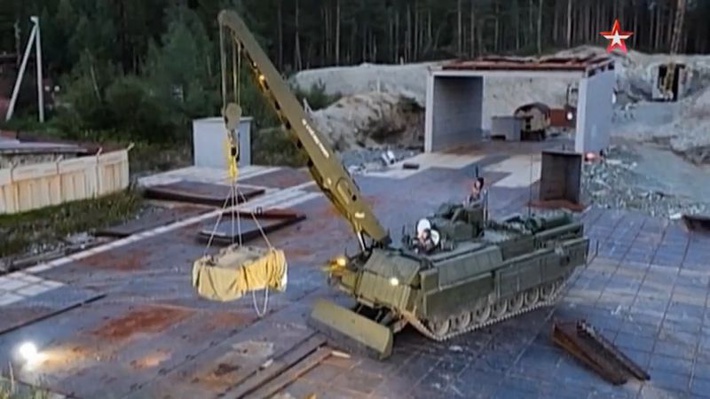
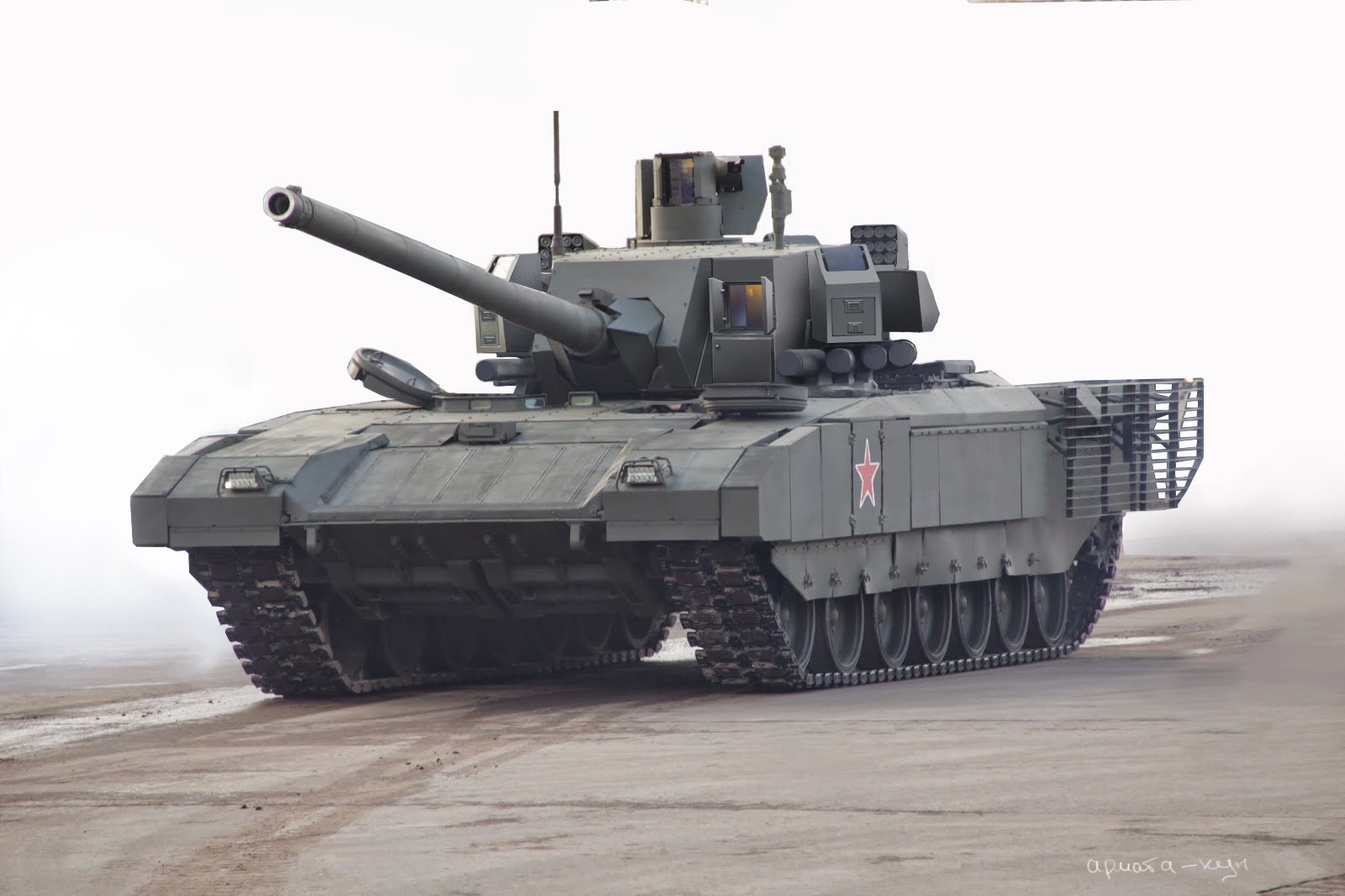
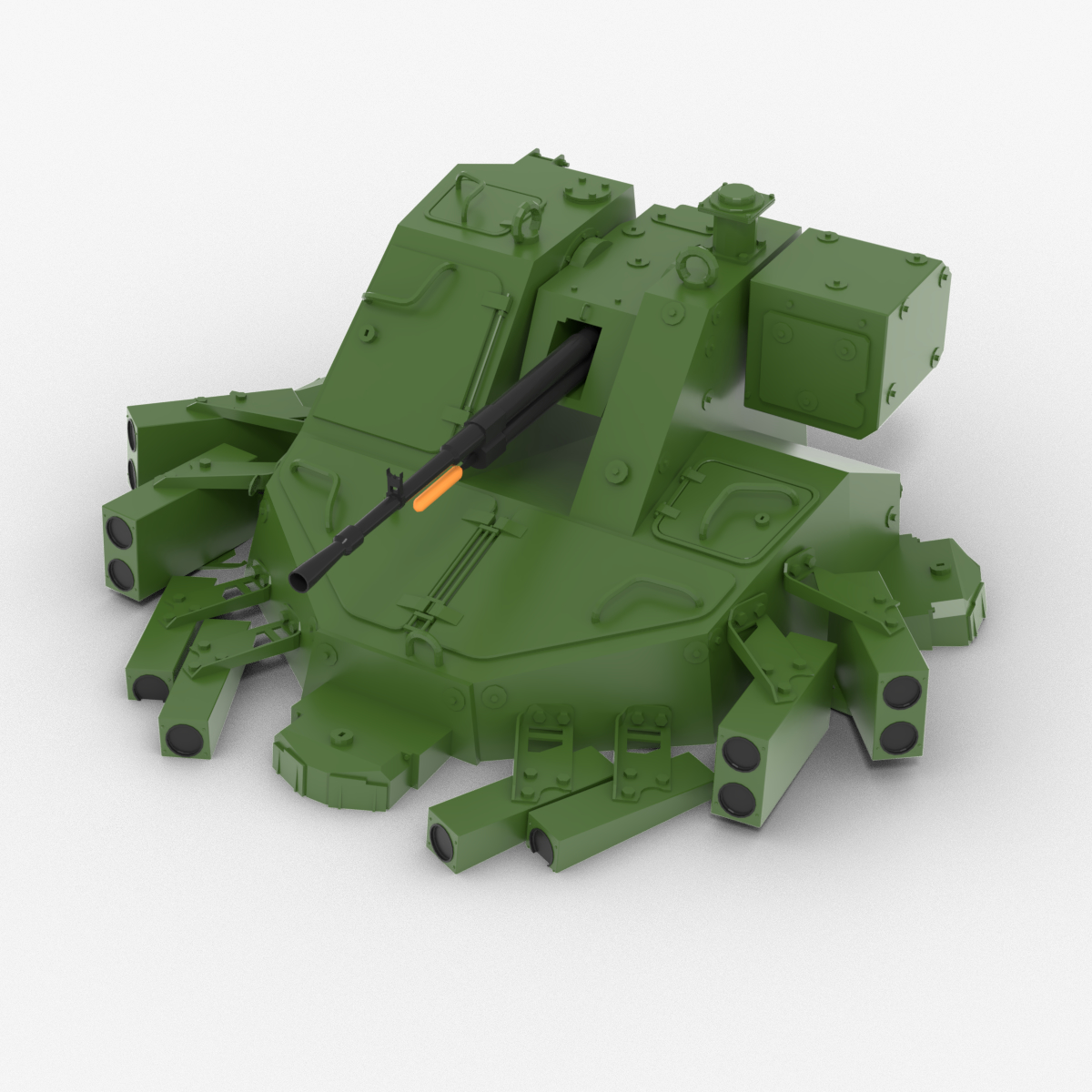

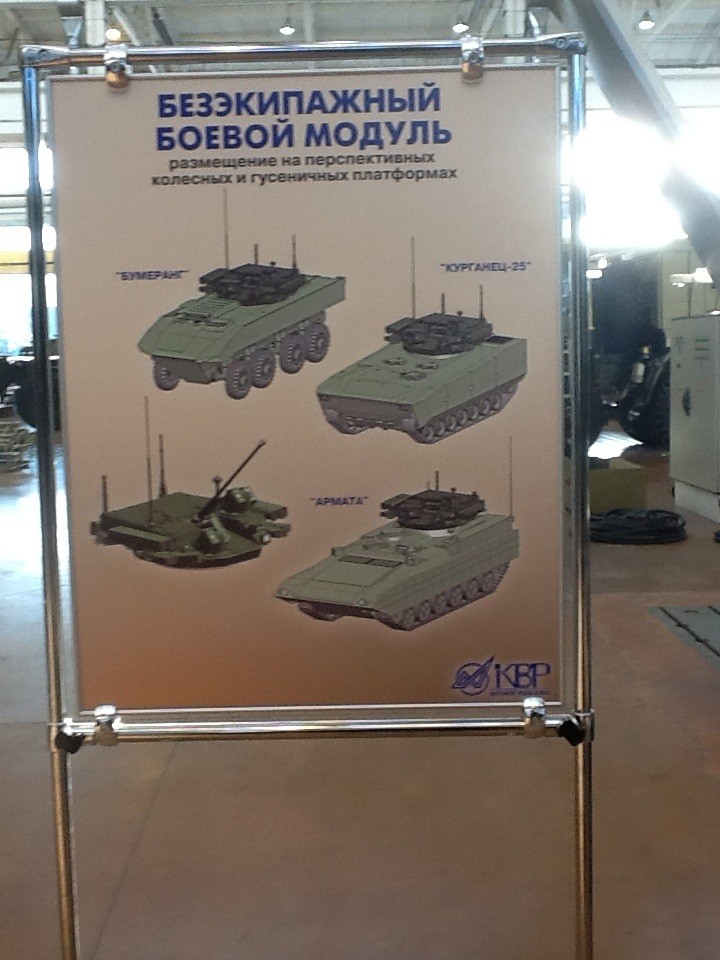

 marcellogo
marcellogo